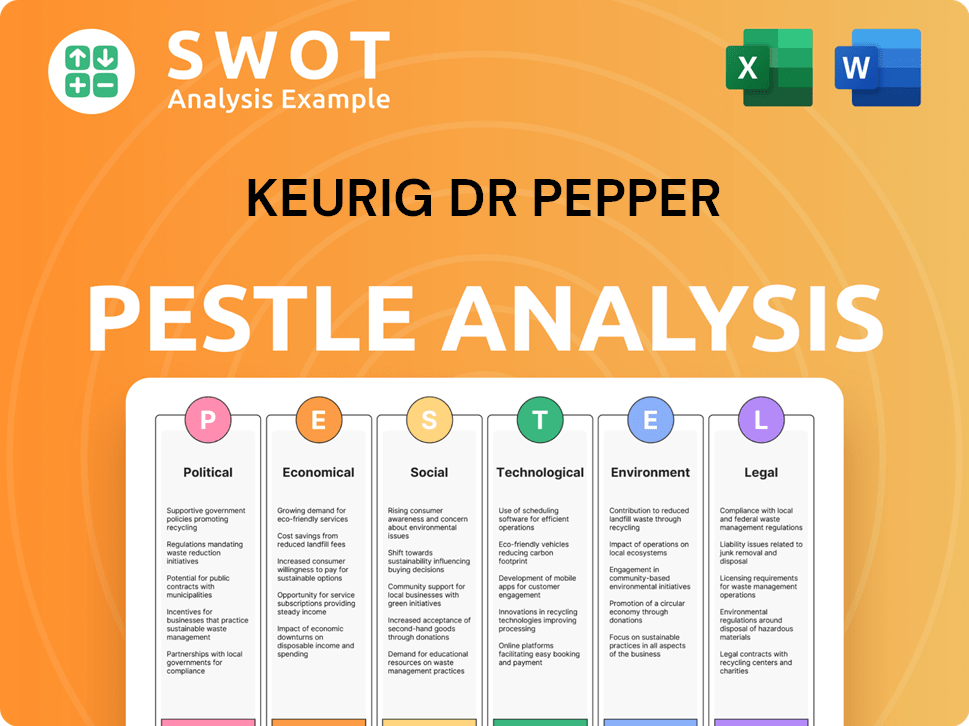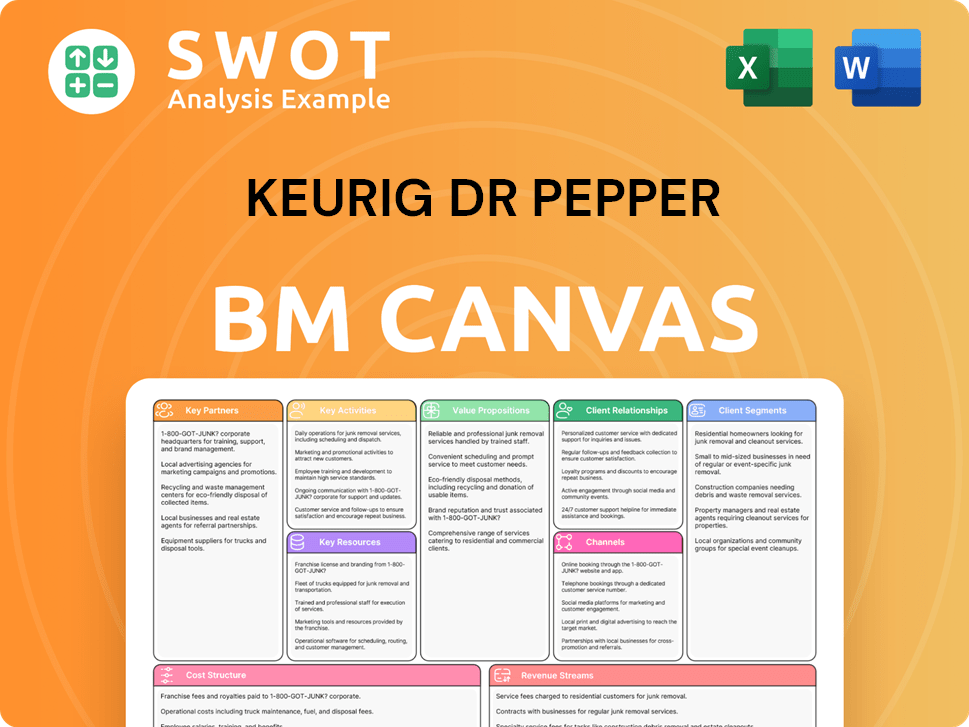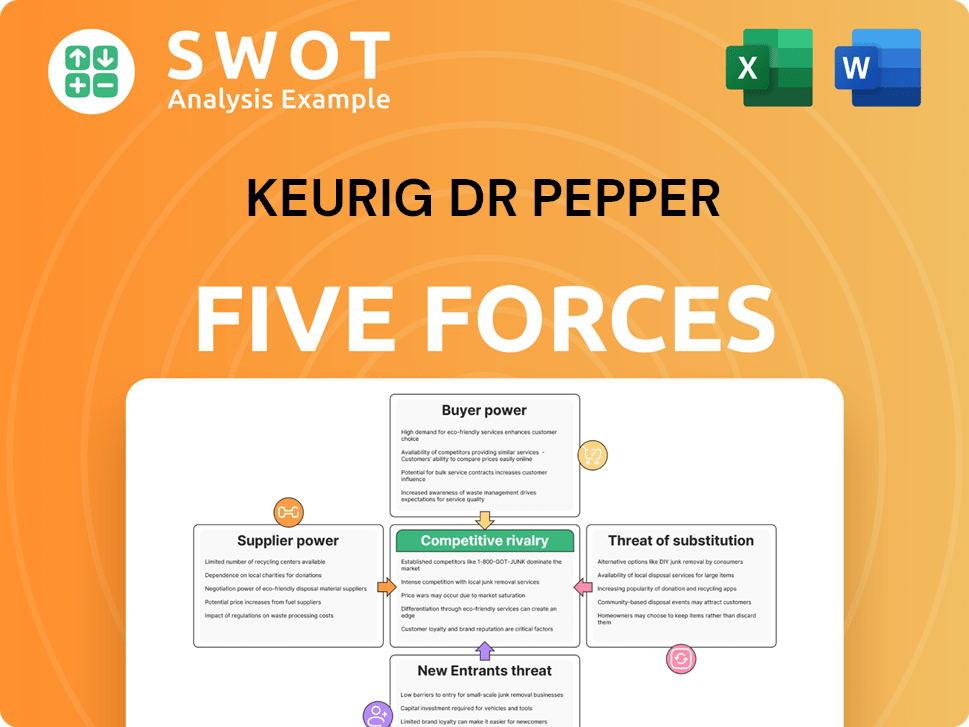Keurig Dr Pepper Bundle
How Did Keurig Dr Pepper Brew Its Success?
The beverage industry's landscape was dramatically reshaped by the advent of single-serve coffee, a game-changing innovation. This transformation is inextricably linked to the Keurig Dr Pepper SWOT Analysis, a company that has become a dominant force in the North American beverage market. Its current form is the result of a pivotal 2018 merger, but its roots lie in the distinct origins of Keurig and Dr Pepper Snapple Group.

Understanding the KDP history is crucial for grasping its current market position. From its early days, the Dr Pepper company and Keurig each pursued distinct paths in the beverage industry, driven by a vision to meet diverse consumer needs. Exploring the Keurig Dr Pepper journey reveals a compelling narrative of strategic evolution, market adaptation, and the power of mergers and acquisitions, shaping its impact on the beverage market.
What is the Keurig Dr Pepper Founding Story?
The story of Keurig Dr Pepper (KDP) is a fascinating blend of two distinct histories, each with its own unique origin story. This narrative traces the paths of Keurig and Dr Pepper, highlighting their respective foundings and the evolution that led to their eventual merger. Understanding the Competitors Landscape of Keurig Dr Pepper is crucial to grasping the company's current position in the beverage industry.
Keurig's journey began in 1992, while Dr Pepper's roots stretch back to the late 19th century. The merger of these two companies created a beverage giant with a diverse portfolio and a rich heritage. This chapter explores the key events and individuals who shaped the early years of both Keurig and Dr Pepper.
The KDP history provides a compelling example of how innovation and strategic vision can lead to remarkable growth and market dominance in the beverage industry.
Keurig, Inc. was established in 1992 by Peter Dragone and John Sylvan in Burlington, Massachusetts. Their initial goal was to revolutionize office coffee by introducing a single-serve brewing system. The founders, both engineers, focused on developing innovative brewing technology to ensure a fresh cup of coffee every time.
- The business model centered on selling brewing machines and proprietary K-Cup pods.
- Early investors initially questioned the viability of the single-serve coffee system.
- The company aimed to solve the problem of stale, burnt office coffee.
- Keurig's focus was on creating a fresh, consistent cup of coffee with each brew.
Dr Pepper's origin dates back to 1885, when pharmacist Charles Alderton created the unique soft drink in Waco, Texas. Served commercially on December 1, 1885, it is the oldest major soft drink in America. The initial business model involved producing and distributing the unique soda locally.
- Charles Alderton created the drink at Morrison's Old Corner Drug Store.
- The soda's unique flavor profile quickly gained a loyal following.
- The cultural context of soda fountains provided fertile ground for new beverages.
- Dr Pepper expanded through bottling agreements and acquisitions.
Keurig Dr Pepper SWOT Analysis
- Complete SWOT Breakdown
- Fully Customizable
- Editable in Excel & Word
- Professional Formatting
- Investor-Ready Format

What Drove the Early Growth of Keurig Dr Pepper?
The early growth and expansion of Keurig Dr Pepper (KDP) involved distinct trajectories for its founding companies. Keurig, Inc. initially focused on the office coffee market, while Dr Pepper's early growth centered on regional expansion and product diversification within the beverage industry. These differing paths laid the groundwork for the eventual merger that created the modern KDP.
Keurig, Inc., founded in 1992, initially targeted businesses with its single-serve coffee system. The company spent several years refining its brewing technology and K-Cup pod design. The introduction of the first Keurig brewer and K-Cup in 1998 marked the beginning of its expansion. Early growth was slow but steady, primarily in office environments. The company's early team expansion focused on engineering and sales, with initial office locations in Massachusetts.
A pivotal moment came in 2006 when Green Mountain Coffee Roasters acquired Keurig, Inc. This merger provided Keurig with significant capital and access to a broader distribution network. This strategic move enabled Keurig to expand into the residential market, which proved to be a larger consumer base. Keurig's growth accelerated dramatically after this acquisition, leading to increased brewer sales and a wider variety of K-Cup offerings. For more details on the Keurig Dr Pepper brands, you can check out this article.
Dr Pepper's early growth, starting in 1885, involved regional expansion and product diversification. After its initial success in Waco, Dr Pepper expanded its bottling and distribution throughout Texas and other Southern states. Securing bottling agreements with local businesses allowed for wider distribution without significant capital investment. Over the decades, Dr Pepper underwent various ownership changes and mergers, increasing its portfolio to include other soft drink brands.
A significant development in the 20th century was Dr Pepper's establishment as a national brand, often through independent bottlers. The distinctive flavor of Dr Pepper allowed it to carve out a niche in the competitive soft drink market. The company's strategy involved organic growth and strategic acquisitions of smaller beverage companies and brands to expand its product offerings and geographical reach. The company has a rich Dr Pepper origin story.
Keurig Dr Pepper PESTLE Analysis
- Covers All 6 PESTLE Categories
- No Research Needed – Save Hours of Work
- Built by Experts, Trusted by Consultants
- Instant Download, Ready to Use
- 100% Editable, Fully Customizable

What are the key Milestones in Keurig Dr Pepper history?
The KDP history is marked by significant milestones, including the merger of Keurig Green Mountain and Dr Pepper Snapple Group in 2018, creating a major player in the beverage industry. This union combined a leading single-serve coffee system with a diverse portfolio of beverages, significantly impacting the coffee and soda markets.
| Year | Milestone |
|---|---|
| 2006 | Green Mountain Coffee Roasters acquired Keurig, expanding into the residential market and fueling growth in brewer sales and K-Cup subscriptions. |
| 2008 | Dr Pepper Snapple Group acquired Snapple Beverage Group, broadening its portfolio of beverages. |
| 2018 | Keurig Green Mountain and Dr Pepper Snapple Group merged to form Keurig Dr Pepper, creating a diversified beverage giant. |
Innovations within the company have been pivotal, particularly in the coffee and soda sectors. Keurig revolutionized home coffee consumption with its K-Cup single-serve brewing system, offering convenience and variety. Dr Pepper, as one of America's oldest soft drinks, has sustained success through early marketing campaigns that solidified its unique identity, influencing the beverage industry.
The introduction of the K-Cup single-serve brewing system transformed how people consumed coffee at home and in the office. This innovation offered unparalleled convenience and a wide variety of beverage options.
Dr Pepper's early marketing campaigns were crucial in establishing its unique brand identity and fostering consumer loyalty. These campaigns helped solidify Dr Pepper's position in the beverage market.
Responding to environmental concerns, the company introduced recyclable K-Cups. This initiative aimed to address the issue of plastic pod waste and align with evolving consumer preferences.
The development of new brewing platforms allowed the company to maintain market share and adapt to changing consumer demands. These platforms offered new features and improved brewing capabilities.
In response to evolving consumer preferences, the company diversified its portfolio to include water, teas, and juices. This strategic move aimed to capitalize on the growing demand for healthier beverage options.
Acquisitions, such as the purchase of Snapple Beverage Group, were crucial in broadening the product portfolio and strengthening market position. These moves helped the company compete effectively in the beverage industry.
Challenges have included navigating competitive pressures and changing consumer tastes. Intense competition from generic K-Cup manufacturers and environmental concerns surrounding plastic pod waste posed significant hurdles. The company also faced the need to adapt to economic downturns and shifts in consumer trends, requiring continuous innovation in product development and marketing strategies.
The rise of generic K-Cup manufacturers intensified competition, impacting market share and profitability. This challenge required the company to differentiate its products and maintain a competitive edge.
Environmental concerns related to plastic pod waste prompted the company to develop recyclable K-Cups. Addressing sustainability issues became increasingly important to consumers and stakeholders.
Changes in consumer preferences towards healthier beverages necessitated diversification into water, teas, and juices. The company had to adapt its product offerings to meet these evolving demands.
Economic downturns and shifts in consumer trends required continuous adaptation in product development and marketing strategies. The company needed to remain flexible and responsive to market conditions.
The 2018 merger presented integration challenges, requiring the harmonization of two distinct corporate cultures and operational structures. Successfully merging the companies was crucial for long-term success.
Leveraging the expanded distribution network and brand portfolio to compete effectively in a dynamic beverage market. This included emphasizing sustainability initiatives and continued product innovation.
Keurig Dr Pepper Business Model Canvas
- Complete 9-Block Business Model Canvas
- Effortlessly Communicate Your Business Strategy
- Investor-Ready BMC Format
- 100% Editable and Customizable
- Clear and Structured Layout

What is the Timeline of Key Events for Keurig Dr Pepper?
The KDP history is a story of innovation and strategic mergers, starting with the creation of Dr Pepper in 1885. The company evolved significantly, marked by the founding of Keurig in 1992 and the subsequent merger of Keurig Green Mountain and Dr Pepper Snapple Group in 2018, forming Keurig Dr Pepper as it is known today.
| Year | Key Event |
|---|---|
| 1885 | Charles Alderton creates Dr Pepper in Waco, Texas, marking the beginning of the Dr Pepper company. |
| 1904 | Dr Pepper is introduced to a national audience at the St. Louis World's Fair. |
| 1992 | Keurig, Inc. is founded by Peter Dragone and John Sylvan, initiating the Keurig company background. |
| 1998 | The first Keurig brewer and K-Cup portion pack are introduced for office use. |
| 2006 | Green Mountain Coffee Roasters acquires Keurig, Inc., accelerating its expansion into the residential market. |
| 2008 | Cadbury Schweppes spins off its North American beverage business as Dr Pepper Snapple Group. |
| 2012 | Keurig Green Mountain introduces the Keurig Vue brewing system. |
| 2014 | Coca-Cola acquires a 10% stake in Keurig Green Mountain. |
| 2015 | Keurig Green Mountain launches the Keurig Kold system, which is later discontinued. |
| 2016 | JAB Holding Company acquires Keurig Green Mountain. |
| 2018 | Keurig Green Mountain merges with Dr Pepper Snapple Group, forming Keurig Dr Pepper. |
| 2020 | Keurig Dr Pepper reports strong financial results, demonstrating the success of the merger integration. |
| 2023 | Keurig Dr Pepper focuses on supply chain optimization and innovation in its ready-to-drink and coffee segments. |
Keurig Dr Pepper is strategically positioned for continued growth in the North American beverage market. The company plans to leverage its extensive direct-store-delivery (DSD) network, which covers approximately 90% of the U.S. population.
Strategic initiatives include expanding its presence in high-growth categories like ready-to-drink coffee, premium water, and functional beverages. The company is also focused on innovating its brewing systems and K-Cup offerings, with a continued emphasis on sustainability, including recyclable K-Cup pods.
The increasing demand for personalized beverage experiences and healthier options is likely to impact Keurig Dr Pepper's future trajectory. Analyst predictions often highlight the company's strong brand equity and extensive distribution as key competitive advantages.
Leadership statements emphasize a commitment to sustainable practices and delivering shareholder value through organic growth and strategic partnerships. The company aims to provide consumers with a wide array of convenient, high-quality beverage choices, whether through innovative brewing technology or established brands.
Keurig Dr Pepper Porter's Five Forces Analysis
- Covers All 5 Competitive Forces in Detail
- Structured for Consultants, Students, and Founders
- 100% Editable in Microsoft Word & Excel
- Instant Digital Download – Use Immediately
- Compatible with Mac & PC – Fully Unlocked

Related Blogs
- What is Competitive Landscape of Keurig Dr Pepper Company?
- What is Growth Strategy and Future Prospects of Keurig Dr Pepper Company?
- How Does Keurig Dr Pepper Company Work?
- What is Sales and Marketing Strategy of Keurig Dr Pepper Company?
- What is Brief History of Keurig Dr Pepper Company?
- Who Owns Keurig Dr Pepper Company?
- What is Customer Demographics and Target Market of Keurig Dr Pepper Company?
Disclaimer
All information, articles, and product details provided on this website are for general informational and educational purposes only. We do not claim any ownership over, nor do we intend to infringe upon, any trademarks, copyrights, logos, brand names, or other intellectual property mentioned or depicted on this site. Such intellectual property remains the property of its respective owners, and any references here are made solely for identification or informational purposes, without implying any affiliation, endorsement, or partnership.
We make no representations or warranties, express or implied, regarding the accuracy, completeness, or suitability of any content or products presented. Nothing on this website should be construed as legal, tax, investment, financial, medical, or other professional advice. In addition, no part of this site—including articles or product references—constitutes a solicitation, recommendation, endorsement, advertisement, or offer to buy or sell any securities, franchises, or other financial instruments, particularly in jurisdictions where such activity would be unlawful.
All content is of a general nature and may not address the specific circumstances of any individual or entity. It is not a substitute for professional advice or services. Any actions you take based on the information provided here are strictly at your own risk. You accept full responsibility for any decisions or outcomes arising from your use of this website and agree to release us from any liability in connection with your use of, or reliance upon, the content or products found herein.